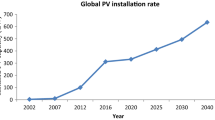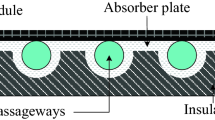Abstract
The use of solar concentrating technique for cooking purpose has been widely reported rather than for the baking process which is rigidly precise and requires process controlled conditions. Secondly, the energy and exergy analyses are rarely made for the baking process. In this paper, an energy- and exergy-based thermal analysis of an innovative solar bakery unit powered by Scheffler reflector has been presented. The system comprised of primary reflector (Scheffler reflector), secondary reflector, receiver and baking chamber. The baking experiments were conducted using four product samples (cakes) at 180 °C. The entire bakery unit was divided into two main parts, i.e. fan–receiver and baking chamber to find out the inefficiencies of bakery unit and its components. It was found that fan–receiver component handled major portion of solar energy and showed energy losses. It possessed high improvement potential (IP) rate (0.153 kW), high exergetic factor (f) value (59.26%) and low exergy efficiency (15%). Thermal analysis of baking process in the baking chamber showed variations in rate of energy utilization, energy utilization ratio, exergy losses and exergy efficiency in range of 0.01–0.07 kW, 25–75%, 0.19–1.08 kW and 6.62–56.46%, respectively. The overall exergy efficiency of system was found to be 59.26%. The study provides a detailed and sequential procedure to perform the thermal analysis of a solar concentrated technology-based bakery unit.











Similar content being viewed by others
Abbreviations
- W :
-
Rate of energy utilization/kJ s−1
- Q net :
-
Net available energy/kJ s−1
- T :
-
Temperature/°C
- η r :
-
Receiver efficiency/%
- m a :
-
Air flow rate/kg s−1
- ω :
-
Specific humidity/g of water kg of dry air−1
- h :
-
Enthalpy/kJ kg−1
- ϕ :
-
Relative humidity/%
- v :
-
Air velocity/m s−1
- C p :
-
Specific heat/kJ kg−1 k−1
- Q d :
-
Heat given by receiver to air as output/kW
- Q R :
-
Heat received by zigzag receiver/kW
- I b :
-
Beam radiations/W m−2
- A p :
-
Aperture area of Scheffler reflector/m2
- A c :
-
Surface area of Scheffler reflector/m2
- δ :
-
Solar declination
- EUR:
-
Energy utilization ratio/%
- Ex:
-
Exergy/kJ kg−1
- Exr:
-
Exergy rate/kJ s−1
- η EX :
-
Exergetic efficiency/%
- f :
-
Exergetic factor/%
- IP:
-
Improvement potential/kJ s−1
References
Pohekar SD, Kumar D, Ramachandran M. Dissemination of cooking energy alternatives in India—a review. Renew Sustain Energy. 2005;9:379–93.
Esen M. Thermal performance of a solar cooker integrated vacuum-tube collector with heat pipes containing different refrigerants. Sol Energy. 2004;76:751–7.
Terres H, Ortega JA, Gordon M, Morales JR, Lizard A. Heating of bee honey, olive oil, milk and water in a solar box type with internal reflectors. In: Energy sustainability conference, Long Beach, California, USA; 27–30 June 2007.
Hussein HMS, El-Ghetany HH, Nada SA. Experimental investigation of novel indirect solar cooker with indoor PCM thermal storage and cooking unit. Energy Convers Manag. 2008;49:2237–46.
Meibodi SS, Kianifar A, Mahian O, Wongwises S. Second law analysis of a nano-fluid-based solar collector using experimental data. J Therm Anal Calorim. 2016;126:617–26.
Kumar RA, Babu BG, Mohanraj M. Thermodynamic performance of forced convection solar air heaters using pin–fin absorber plate packed with latent heat storage materials. J Therm Anal Calorim. 2016;126:1657–78.
Farooqui SZ. A review of vacuum tube based solar cookers with the experimental determination of energy and exergy efficiencies of a single vacuum tube based prototype. Renew Sustain Energy Rev. 2014;31:439–45.
Rabha DK, Muthukumar P, Somayaji C. Energy and exergy analyses of the solar drying processes of ghost chilli pepper and ginger. Renew Energy. 2017;105:764–73.
Sogut Z, Ilten N, Oktay Z. Energetic and exergetic performance evaluation of the quadruple-effect evaporator unit in tomato paste production. Energy. 2010. https://doi.org/10.1016/j.energy.2010.05.035.
Nahar NM. Performance and testing of an improved hot box solar cooker. Energy Convers Manag. 1990;30:9–16.
Nahar M. Studies on a hot box solar cooker with transparent insulation material. Energy Convers Manag. 1994;9:787–91.
Algifri H, Al-Towaie HA. Efficient orientation impacts of box-type solar cooker on the cooker performance. Sol Energy. 2001;70:165–70.
Nouni MR, Mullick SC, Kandpal TC. An energy analysis of box-type solar cooker utilization in India. Int J Ambient Energy. 2008;29(1):45–56.
Sharma SD, Iwata T, Kitano H, Sagara K. Thermal performance of a solar cooker based on an evacuated tube solar collector with a PCM storage unit. Sol Energy. 2005;78:416–26.
Singh H, Saini K, Yadav A. Experimental investigation of the solar cooker during sunshine and off-sunshine hours using the thermal energy storage unit based on a parabolic trough collector. Int J Ambient Energy. 2016. https://doi.org/10.1080/01430750.2015.1023836.
Stumpf P, Balzar A, Eisenmann W, Wendt S, Ackermann H, Vagen K. Comparative measurements and theoretical modelling of single-and double-stage heat pipe coupled solar cooking systems for high temperatures. Sol Energy. 2001;71(1):1–10.
Kumar R, Adhikari RS, Garg HP, Kumar A. Thermal performance of a pressure cooker based on evacuated tube solar collector. Appl Therm Eng. 2001;21:1699–706.
Harmim A. Experimental investigation of a box-type solar cooker with a finned absorber plate. Energy. 2010;35(3):799–802.
Richard P. Exergy analysis of the solar cylindrical-parabolic cooker. Sol Energy. 2005;79:221–33.
Shukla SK, Gupta SK. Performance evaluation of concentrating solar cooker under Indian climatic conditions. In: Second international conference on energy sustainability, Jacksonville, Florida, USA; 10–14 August 2008.
Panwar NL, Kaushik SC, Surendra K. Experimental investigation of energy and exergy efficiencies of domestic size parabolic dish solar cooker. J Renew Sustain Energy. 2012. https://doi.org/10.1063/1.3699615.
Pandey AK, Tyagi VV, Park SR, Tyagi SK. Comparative experimental study of solar cookers using exergy analysis. J Therm Anal Calorim. 2012;109:425–31.
Park SR, Pandey AK, Tyagi VV, Tyagi SK. Energy and exergy analysis of typical renewable energy systems. Renew Sustain Energy Rev. 2014;30:105–23.
Zamani H, Mahian O, Rashidi I, Lorenzini G, Wongwises S. Exergy optimization of a double exposure solar cooker by response surface method. J Therm Sci Eng Appl. 2017;9:011003-1. https://doi.org/10.1115/1.4034340.
Mbodji N, Hajji A. Modelling, testing and parametric analysis of a parabolic solar cooking system with heat storage for indoor cooking. J Energy Sustain Soc. 2017;7:32. https://doi.org/10.1186/s13705-017-0134-z.
Hassen A, Kebedy SB, Wihib NM. Design and manufacturing of thermal energy based Injeria baking glass pan. Energy Procedia. 2016;93:153–9.
Tesfay AH, Kahsay MB, Nadal OJ. Design and development of solar thermal injeria baking; steam based direct baking. Energy Procedia. 2013;57:2946–55.
Sansaniwal SK, Sharma V, Mathur J. Energy and exergy analyses of various typical solar energy applications: a comprehensive review. J Sustain Energy Rev. 2017. https://doi.org/10.1016/j.rser.2017.07.003.
Schirmer P, Janjai S, Esper A, Smitabhindu R, Muhlbaur W. Experimental investigation of the performance of the solar tunnel dryer for drying Bananas. Renew Energy. 1996;7:119–29.
Midilli A, Kucuk H. Energy and exergy analyses of solar drying process of pistachio. Energy. 2003;28:539–56.
Mujumdar AS. Hand book of industrial drawing. 2nd ed. New York: Marcel Dekker; 1995.
Amjad W, Hensel O, Munir A, Esper A, Sturm B. Thermodynamic analysis of drying process in a diagonal-batch dryer developed for batch uniformity using potato slices. J Food Eng. 2016;169:238–49.
Holman JP. Experimental methods for engineers. 6th ed. Singapore: McGraw-Hill; 1994 (International ed.).
Erbay Z, Icier F. Energy and exergy analyses on drying of olive leaves (Olea europaea) in tray drier. J Food Process Eng. 2011;34(6):2105–23.
Ozturk HH. Comparison of energy and exergy efficiency for solar box and parabolic cookers. J Energy Eng. 2007;133(1):53–62.
Kumar N, Vishwanath G, Gupta A. An exergy based unified test protocol for solar cookers of different geometries. In: World Renewable Energy Congress 2011 Sweden, Solar Thermal Applications, 2011; p. 3741–8.
Acknowledgements
The authors wish to acknowledge the Department of Energy Systems Engineering, University of Agriculture Faisalabad, Pakistan, and International Centre for Development and Decent Work (ICDD), Germany, for the financial support.
Author information
Authors and Affiliations
Corresponding author
Rights and permissions
About this article
Cite this article
Ayub, I., Munir, A., Amjad, W. et al. Energy- and exergy-based thermal analyses of a solar bakery unit. J Therm Anal Calorim 133, 1001–1013 (2018). https://doi.org/10.1007/s10973-018-7165-3
Received:
Accepted:
Published:
Issue Date:
DOI: https://doi.org/10.1007/s10973-018-7165-3




